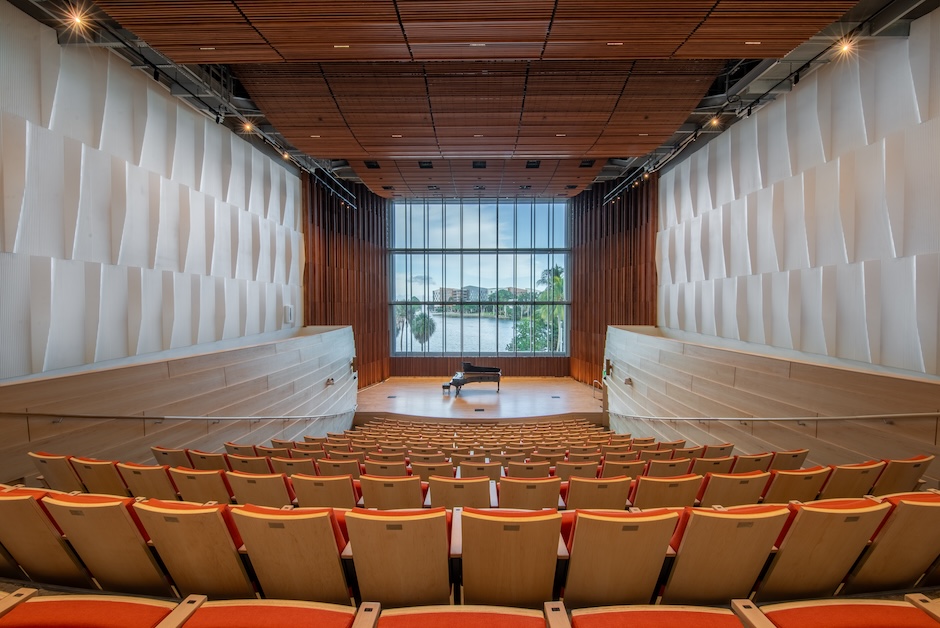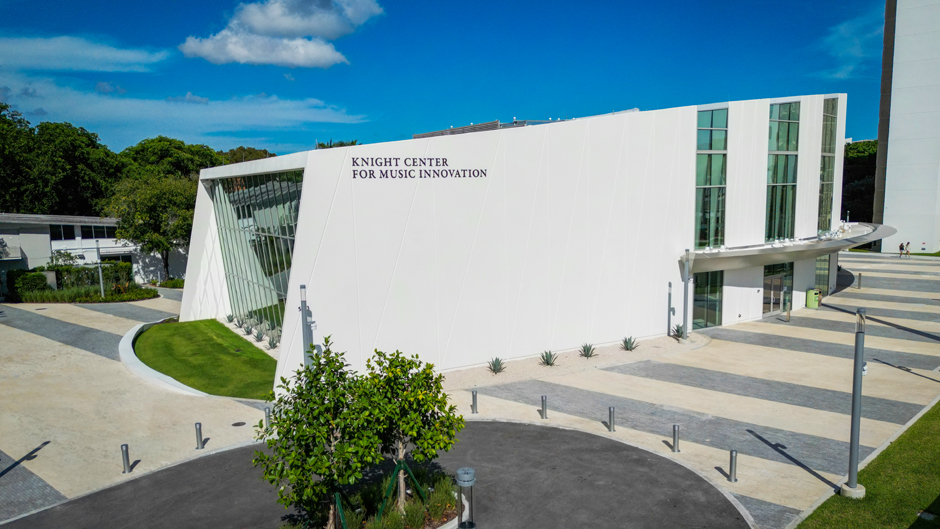Music lovers attest that certain music invokes the sublime, its titillations resonating in the spiritual realm and reminding us of our highest human potential. The space where music is played, heard, and experienced has much to do with whether it reaches that starry aural stratosphere.
The University of Miami now offers such a space: the Knight Center for Music Innovation.
“Universities were founded to be centers of research and experimentation, and the Knight Center for Music Innovation is an essential, physical hub for innovation at the Frost School of Music,” said Shelton “Shelly” Berg, dean of the Phillip and Patricia Frost School of Music.
“Musicians will continue to perform music spanning centuries of creativity, but more and more technology and cultural diversity will figure prominently in our work,” the dean added. “Our students and graduates will need to master technology along with musical artistry. They will need to be comfortable with a more interactive relationship with audiences that technology empowers and able to leverage musical relationships that cross traditional borders of genre and culture.”
Interactivity is one of the prime principles that shaped both the conceptualization and the construction of the new performance and technology center, according to Reynaldo “Rey” Sanchez, music professor and associate dean for strategic initiatives and innovation.
“This new center is the kind of asset that can push the school to the next level,” Sanchez said. “It’s more than a performance space—this is something else altogether. This really gives us a blank canvas to do so many things.
“I really believe that a space helps create the music,” Sanchez added. “A space is not just to put music in, it’s to get music out, and these spaces we created are going to incentivize lots of new creativity.”
Berg highlighted some of the novel components of the $36.5 million, 25,000-square-foot new performance and technology space located in the heart of the Coral Gables Campus.
“Frequent ‘windowcasts’ will display performances from the Robert and Judi Prokop Newman Recital Hall in HD video on a 20x40-foot window to a plaza, requiring new considerations of stage presence, lighting, and sound reinforcement,” the dean noted. “The Thomas D. Hormel Innovation Stage will incubate experimentation with augmented and mixed reality, AI, volumetric video capture, surround audio, and technologies yet to be identified.”
The massive west-facing window, made of “smart glass” that can be switched from clear to opaque and that allows for vision to be directed inward or outward, will be utilized for the “Windowcasts.”

A Cohesive Part of Campus
Jessica Brumley, vice president for Facilities Operations and Planning, emphasized that the new center aligns strategically within the University landscape.
“The Knight Center is an extraordinary facility that incorporates the latest technologies and innovations, and its construction continues the University’s commitment to green initiatives and LEED certification with a focus on sustainable design,” Brumley said.
“The proximity to Lake Osceola adds to the aesthetic and community togetherness that was started by the opening of the Shalala Student Center a decade ago and continued with the amazing student housing additions of Lakeside Village and Centennial Village,” she added.
Deborah Hunley, assistant vice president for the Design and Construction Department, has been part of the team overseeing construction since she joined the University a year ago.
“The building design is very unique in its curvature and placement on our campus,” Hunley said. “The prime focus of the recital hall’s large picture window is to direct the view onto the lake, and that view is definitely the first thing that everyone talks about—it’s absolutely gorgeous.”
A Culture of Innovation
Sanchez has been researching to craft a 10-minute immersive experience that documents the story of innovation at the Frost School from 1965 to the present. The presentation will play as part of Frost Tech Day on Nov. 4, one of nine Knight Opening Festival events that take place in late October and early November.
“The history is amazing—it could have been a Hollywood script,” Sanchez said of his findings. He credited the late William F. Lee III, jazz pianist, composer, arranger, and third dean of the school from 1964-82 with setting the innovation tempo. The Frost School now is among the top 10 music schools in the country.
“Bill Lee was so far ahead of his time and helped create a culture that’s been here for a long time. It seems like with every new step of innovation a new building is built, and then that new building spurred more new creativity,” Sanchez said.
Jeffrey Buchman, associate professor and stage director for opera, was among the wide swath of voices engaged in 2018 to conceptualize a Frost School space that would shape the future of music.
“Ultimately, spaces like this are meant to bring talents together in collaborative ways and also to bring audiences together in more interactive ways,” said Buchman, who will be producing an opera in the center in the spring.
Buchman, who has extensively researched mixed and augmented reality and has a long history of using multimedia in his operatic productions, celebrated the sophisticated technology that the center offers and that its directors continue to explore. He emphasized, though, not to confuse “technology” with “innovation.”
“All these types of technology that we’re exploring and playing with and utilizing are not in and of themselves innovation—they are just tools that these wonderful creative minds, whether they be students or the faculty, are now able to employ to further innovation,” Buchman said.
Sanchez’s recommendation in the early conversations that permanent technology installations be minimized became another of the guiding principles for the design and construction. Versatility and flexibility define the use of space.
“Because whatever we decide with technology in 2018 is going to be moot by the time we would open,” he said. “You need flexibility above all else in order to have a venue that adapts with technology.”
Design Distinctions
Ariel Fausto, design principal for H3, the architectural firm which designed the center, marked the distinctions between the building’s two primary venues. They are the recital hall, a classically fixed acoustically sensitive room, and the fully flexible innovation stage, with an open floor and a grid above in the ceiling to allow for sound and lighting configurations.
Fausto also highlighted the recital hall’s two intentions.
“As a state-of-the-art musical venue, the hall serves to prepare students for professional life, so there is that inward focus, but simultaneously it is leveraging technology and a building in a way that makes music more accessible to the entire campus,” he said.

“The visual transparency of the recital hall—created by the large window that faces the lake—allows for passersby to see at any moment when a performance is happening and telegraphs the energy from within the building,” Fausto explained.
The technology on the building’s other façade, which looks onto the Music Innovation Plaza, allows for simulcast projection onto the curtain wall.
“That piece of media technology on the glazing is really an innovative way to expand the experience of music to people outside the building,” he said.
Sanchez celebrated the design of the recital hall that allows for ample seating. And its refined acoustics that accommodate any performance size, whether full orchestra or small ensemble. And the sophisticated technology offers the potential for a performance such as a two-piano concert with one pianist on stage and the other across the country.
The Hormel Innovation Stage, named in honor of Thomas Hormel, a renowned innovator in both music and art, is essentially a black box, albeit a very high-tech, hybrid one, Sanchez explained.
While its floors are black, the walls are white and its acoustical panels can be used for “projection mapping,” a technique of visually creating 3D dimensionality. The space has no permanent seating and can be configured for a wide array of different performances.
For the opening event, the room will be set up with couches and sofas, with a bar in the middle. A 12:1 immersive video and audio system will broadcast the presentation.
“The whole idea is to showcase the many possibilities, and we’re just scratching the surface here,” said Sanchez.
An Aim to Engage
Every facet of the new center is geared to promote engagement and innovation, Sanchez noted.
“Music at its core is all about engagement with others,” he said. “If there’s no engagement between the performers and the music, the performers with each other, and the performers and the audience, then we don’t have anything. So that’s what the technology is helping us achieve.”
The new Knight Center for Music Innovation is designed not just to capture the innovations already going on, but also to spur new ones.
“The center is fully designed to be cross genre, not just tricked out for one kind of music,” Sanchez said. “That was the whole thing, because we don’t know what music is going to sound like in 20 years.”

